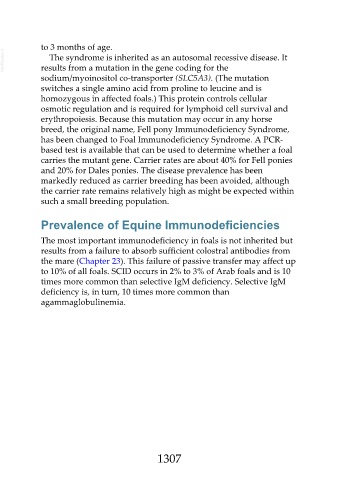Page 1307 - Veterinary Immunology, 10th Edition
P. 1307
to 3 months of age.
VetBooks.ir results from a mutation in the gene coding for the
The syndrome is inherited as an autosomal recessive disease. It
sodium/myoinositol co-transporter (SLC5A3). (The mutation
switches a single amino acid from proline to leucine and is
homozygous in affected foals.) This protein controls cellular
osmotic regulation and is required for lymphoid cell survival and
erythropoiesis. Because this mutation may occur in any horse
breed, the original name, Fell pony Immunodeficiency Syndrome,
has been changed to Foal Immunodeficiency Syndrome. A PCR-
based test is available that can be used to determine whether a foal
carries the mutant gene. Carrier rates are about 40% for Fell ponies
and 20% for Dales ponies. The disease prevalence has been
markedly reduced as carrier breeding has been avoided, although
the carrier rate remains relatively high as might be expected within
such a small breeding population.
Prevalence of Equine Immunodeficiencies
The most important immunodeficiency in foals is not inherited but
results from a failure to absorb sufficient colostral antibodies from
the mare (Chapter 23). This failure of passive transfer may affect up
to 10% of all foals. SCID occurs in 2% to 3% of Arab foals and is 10
times more common than selective IgM deficiency. Selective IgM
deficiency is, in turn, 10 times more common than
agammaglobulinemia.
1307

